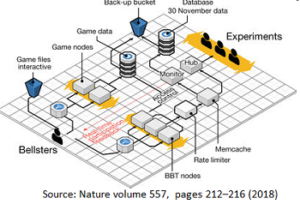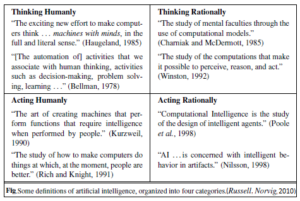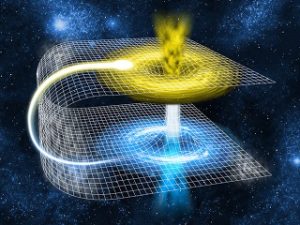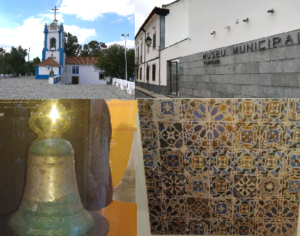
Arquivo para a ‘Information Science’ Categoria
Effect contested by Einstein is proven
The phantasmagoric effect at a distance, which is the fact that particles can relate  to distance and the effect of being “felt” by the other distance, is definitely proven in an experiment published by Nature on May 9.
to distance and the effect of being “felt” by the other distance, is definitely proven in an experiment published by Nature on May 9.
This test is called Bell, due to John S. Bell, was first shown by Alain Aspect who did an optical experiment in 1982, showing this action at a distance. Now the experiment was done recruiting 100,000 human participants to play an online video game that encourages the rapid entry of unpredictable selections and illustrates Bell’s test methodology, participants generated more than 97 million binary choices that were directed through a Web platform Scalable to 12 labs on five continents, where 13 experiments tested local realism using unique atomic photons, atomic clusters and superconducting devices (illustration).
For a period of 12 hours on November 30, 2016, participants around the world provided a sustained data stream of more than 1,000 bits per second for the experiments, using different human-generated data to choose each measurement configuration, correlations strongly contrast local realism and other positions in so-called bipartite and tripartite scenarios.
The results of the project included closing the “freedom of choice” gap (the possibility of scenario choices being influenced by hidden variables to correlate with particle properties), the use of video game methods for the rapid collection of generated randomness and the use of network techniques for global participation in experimental science.
Two data are fantastic from this experiment, proving the phantasmagoric distance action that Einstein contested in an article called EPR, the use of network methodologies in participation in global experimental science, and the use of the video games to simulate data.
AI and artifacts
Norvig and Russel’s book (2010) at the outset brings a table about thinking humanly and  rationally, and acting humanly and rationally, the complete table for Artificial Intelligence is incomplete, even if considering the literature in the area on issues such as autonomy and consciousness.
rationally, and acting humanly and rationally, the complete table for Artificial Intelligence is incomplete, even if considering the literature in the area on issues such as autonomy and consciousness.
Let us first analyze the four main quotations that are in the table of figure 1.1. of the book exemplified next, on Artificial Intelligence.
Thinking Humanly
“The exciting new effort to make computers think . . . machines with minds, in the
full and literal sense.” (Haugeland, 1985)
“ The automation of activities that we associate with human thinking, activities such as decision-making, problem solving, learning . . .” (Bellman, 1978)
Thinking Rationally
“The study of mental faculties through the use of computational models.” (Charniak and McDermott, 1985)
“The study of the computations that make it possible to perceive, reason, and act.” (Winston, 1992)
Acting Humanly
“The art of creating machines that perform functions that require intelligence when performed by people.” (Kurzweil, 1990)
“The study of how to make computers do things at which, at the moment, people are better.” (Rich and Knight, 1991)
Acting Rationally
“Computational Intelligence is the study of the design of intelligent agents.” (Poole et al., 1998)
“AI . . . is concerned with intelligent behavior in artifacts.” (Nilsson, 1998)
I understood from this framework that I am acting rationally, and that definitions and Poole and Nilsson are useful for my studies, but something is lacking, which is consciousness and autonomy, and in this sense the picture is incomplete.
But the question of consciousness is a fact, if we think a person may be aware, but an artifact, not Thomas Nagel’s argument, we can in the opposite sense think of AI “weak” and IA “strong” definitions given by John Searle, to differentiate whether machines are thinking rationally and humanly (strong AI) or just thinking and acting rationally (weak IA).
This led to another field that is today called general IA and deep IA.
NORVIG, P.; RUSSEL, P. (2010) Artificial Intelligence: A Modern Approach 3nd ed., Upper Saddle River, New Jersey: Prentice Hall, 2010.
How do we think it is to think
From the Algebra of 0 and 1 of Boole, through the first computers of Charles Babbage, arriving  at the thoughts of Vannevar Bush and Norbert Wiener of the MIT of the 40, we came across Alan Turing and Claude Shannon, the final question: the machine one day will think
at the thoughts of Vannevar Bush and Norbert Wiener of the MIT of the 40, we came across Alan Turing and Claude Shannon, the final question: the machine one day will think
What we see between Sophia Robot’s investment appeal to the “personal assistants” market is a long history of what it means to think, but the question now due to technoprofets (name given to the alarmists by Jean-Gabriel Ganascia) is inevitable.
Vannevar Bush had a data processing machine in his MIT lab, where he went to work a trainee named Claude Shannon, says James Gleick who was the one who suggested to his student that he study Boole’s Algebra.
Vannevar Bush in his historical text As We May Think, although it does not say as we would think, speaks of the future possibilities of new advances: “Consider a future device … in which an individual stores all his books, records, and communications, and which is mechanized so that it may be consulted with exceeding speed and flexibility. It is an enlarged intimate supplement to his memory.” (Bush, As We may think).
It creates the embryonic idea of a computer that relates text, as it has done in searches since the beginning of the Gutenberg print, but its Memex machine (picture) was already thought of as a vast capacity of records and communications, even if the phone was still nascent in the final years of World War II and communications depended on powerful antennas.
What is certain is that in the end your text little or almost nothing says about what is actually thinking and as it still is today in Artificial Intelligence, what we have done is to expand more and more the capacity of memory and communication, as well as of large amounts of data, now with techniques called Big Data.
Another contemporary tendency is to ask for the autonomy of the machines, the experiments carried out, even with the so-called “autonomous vehicles” are the basis of algorithms and they depend on the decision making of how the human being will do in certain circumstances, in critical cases, like deciding between two tragedies, the choice can be terrible.
World created beyond the imaginary
The story of Claude Shannon, who worked in a MIT laboratory of Vannevar Bush and Alain Turing crosses through World War II, while working on secret projects, which were two sides of the same coin, unaware of one another’s project, the idea of passing the language to a human code, the System X that worked Shannon, and the one of Turing that was to decipher the code of the Machine Enigma capture of the German army.
of Vannevar Bush and Alain Turing crosses through World War II, while working on secret projects, which were two sides of the same coin, unaware of one another’s project, the idea of passing the language to a human code, the System X that worked Shannon, and the one of Turing that was to decipher the code of the Machine Enigma capture of the German army.
Not being able to talk about his projects, speaking at lunches and gatherings in Gödel’s Incomplete Theorem, and the idea of creating a machine that could encode human thought, he said in a joke, “could be a mundane brain like that of the president of Bell Laboratories”, place of secret projects in development.
Bell Labs began as an AT & departament in Washington and later of independent labo of the project’s development (photo above).
The major obstacles to innovation initiatives stem from the mental blocks caused by unproven beliefs, prejudices and perceptions about the possibilities of technology, which are not only strongly alienating, but are inhibitors of creativity and can condemn processes of poor mental development. In spite of the irony of Shannon and Turing with the president of Bell Laboratories, there developed from the first valves, the first transistor that was awarded a Nobel Prize, the telephone systems in their most diverse versions arriving the dialed line and the use of the network for transmission over the internet, and the optimal fiber system, whose first test was done in Georgia.
Also lines of radio and television handsets, the development of the Linux precursor UNIX system, the first solar cells, several Nobel prizes and famous students passed by.
The challenge of pioneers is never simple, critics are always willing to devalue the human effort of progress, Bell Laboratories and other study centers, such as CERN and Research Institute around the world, Brazil has some of them as INPE in São José dos Campos, are central drivers of human creativity and project the future of man.
Clearing and revelation
Will there be in the whirlwind of answers and anguishes of the man of our time, present more than ever in our daily thinking and also in those who seek the roots of our contemporary difficulties? What is the maze with no way out?
our time, present more than ever in our daily thinking and also in those who seek the roots of our contemporary difficulties? What is the maze with no way out?
The answers are not the same, but the diagnoses are almost always the same, in addition to the pessimistic baumanian liquidity, the diagnosis is the needs of education for life, respect for diversity, income distribution, and man’s empowerment for this future .
Although the majority already feel and see the awakening of this new era, the reactions to the changes that are more than necessary, are urgent, there is greater balance in the planet, control of tax havens, elimination of atomic weapons, and especially respect for diversity.
What keeps us still are the closures in bubbles, which despite the “liquidity” can not be solid, since they are ephemeral and just look around you will find people from other world views, other cultures and other religions, this is solid and definitive.
What Strikes Us Attention Byung-Chul Han in The Expulsion of the Other, I believe is his most recent book, is that the tendency toward uniformity, even the desire for it, stems from not-so-solid values, the demand for a centralizing and ” strong, “the lack of truly open dialogue between religions, cultures, and especially ideologically centralized currents, will not carry out the task of a new, more collective, more dialogic and fraternal society.
There is no single answer, single party, Portugal for example, created the Gerigonça, but still we are slaves of convictions and bets on single totalitarian currents that have failed to much.
The biblical message is old, but it seems to have been little practiced, the time of bondage has passed, says the biblical passage, of Jesus to his fellows Jo (15,15) “No longer do I call you servants, for the servant does not know what your lord. I call you friends, for I have made known to you all that I have heard from my Father “, but slavery is there, says Chul Han:” global communication and of the likes only tolerates the most equal; the same does not hurt! “, this is today’s bondage.
Clarify the clearing
Man always wanted the light, he always went in  search of the “clearing”, the Myth of the Cave of Plato is nothing else, the light in the medieval chapels and arts, the clarification (Aufklärung) that Kant pointed out as the man’s exit from his minority and the current “clearings” of Heidegger and “clarifying” Sloterdijk glades, the plural is on my own.
search of the “clearing”, the Myth of the Cave of Plato is nothing else, the light in the medieval chapels and arts, the clarification (Aufklärung) that Kant pointed out as the man’s exit from his minority and the current “clearings” of Heidegger and “clarifying” Sloterdijk glades, the plural is on my own.
In medieval art the “light” must be associated with art, although the texts of Boethius, Thomas Aquinas, Averrois and many others are worthy of reading and analysis, it was in the arts that the idea of luminosity was more present, an example, is the church Saint-Chapelle (photo) consecrated in 1248 AD, with example of the dematerialization of the walls and substitution by stained glass.
What should be the exercise of full freedom, the great bet of modernity, actually confined humanism to a dead end, enough to ask the question if we live in an enlightened age, opinions of all philosophical nuances will answer: it is not an enlightened time, so the pretense of enlightenment gave blindness and civilization crisis.
Heidegger’s answers about the “clearing” in the midst of this forest of questions (some think it is only information) was the resumption of being, certainly important, but Sloterdijk’s response to the letters on humanism puts it in question: that is “clearing.”
I do not have a definitive answer, as Sloterdijk is not, even if he points “the spheres” as the circles of imprisonment of being, of thought and I would say here, even religion.
My response contemplates Byung-Chul Han’s book “Expulsion from the Other,” the option for a massified, uniformed society and for that without values would destroy the human wealth of diversity, but it is precisely this diversity that seems to rebel, and may give fruits. Clarifying the clearing, in the face of the civilizing crisis of our time, can not find more answer, as in the past, in the idea of single thinking, diversity is now necessary.
Utopia and Confusion
Before proceeding to show the relation between being and technique,  one must make a digression for the catastrophic technician-prophecies and the confucioness, that is to say, it is called network nor everything that is network, lends itself the artificial intelligence to human while the opposite is true, and finally, post-human machines are created without an existential response to man.
one must make a digression for the catastrophic technician-prophecies and the confucioness, that is to say, it is called network nor everything that is network, lends itself the artificial intelligence to human while the opposite is true, and finally, post-human machines are created without an existential response to man.
Brade Runner 2049 could not succeed, who better than the first one takes a plunge into the human existential problem, while “Androids dream of electric sheep?” Asks in his book Philip K. Dick, who inspired the films of the series, is 1968 (sic), including a hardcover edition to celebrate the 50 years recently.
Confusioness is a term coined by Lucien Sfez, who in addition to communication participated in the projects Genome, Biosphere II and Artificial Life, so it is not someone who speaks without understanding the possibilities, the daydreams and the challenges of technology.
At the same time recognizes, among the daydreams of course, “The utopia of a total record; to make a being in our image, as a man is that of God, thanks to science, indisputable, transparent, luminous as a sacred gladius; the belief in the omnipotence of an electronic science; the illusion of freedom; and the creation of a perfect machine “(SFEZ, 1996).
I would not use the word utopia, I consider it a confusioness one, since what Thomas Morus wrote would be a community society without attachments and with a “social health” greater than that dreamed by the Enlightenment, and which is the very science that created this confusional and not Thomas Morus (1478-1535), was not a dreamer was a statesman, held various public offices, including Henry VIII’s chancellor, who was precisely his tormentor for religious reasons.
The limits of the technique are within the possibilities and challenges, among these are those that allow space travel no longer in large ships, but in micro-ships that would travel in quantum worm-holes and computers that use larger techniques volume of data, with greater volume of data communicated and processed.
In the field of possibilities it is worth reading “Physics of the Impossible” (2008) by Michio Kaku, among the field of challenges is worth reading “Le Mythe de la Singularité” by Jean-Gabriel Ganascia (2017), who tunes the challenges of Artificial Intelligence and punctuates points of pure fantasy.
I will not resort to more arguments, it is impossible to convince anyone in the field of hypotheses does not abandon the hypothesis of the transhuman or the machine smarter than the man, just see the delusions about today’s social media, use the argument of a saint, perhaps few will know this phrase of St. Francis: “Begin by doing what is necessary, then what is possible, and suddenly you will be doing the impossible”, it is true that it speaks in the field of mysticism, but who said that it is separated from the physical world or at least the meta- physicist.
SFEZ, Lucien. (1996) Saúde Perfeita – crítica a uma nova utopia (Perfect health – criticism of a new utopia). São Paulo: Loyola.
Life and the Vine
The tree that gives the fruits of the grape is particular, first by the I am vine name because it gives the life to one of the fruits more rooted in the cultures due to the wine, and also is curious because its trunk and its shade are of little value, and there are still the aspect that it dries and must be pruned.
first by the I am vine name because it gives the life to one of the fruits more rooted in the cultures due to the wine, and also is curious because its trunk and its shade are of little value, and there are still the aspect that it dries and must be pruned.
If civilizing processes are cyclical use of the vine metaphor seems conducive to understanding the ways of humanity, a generation grows on a particular culture, but almost always question exactly why young people look to the future, their future.
Who would have thought that the solid Roman empire would decay before the Persians, the Portuguese conquerors, the Napoleonic wars, the Soviet Union, and now the resilient money empire.
Analyst of diverse levels types, currents and thinkers of various specialties are convinced, civilization undergoes one of these changes and it is a critical time of options.
There are in our view three essential points: combating centralization of capital and corruption on a world scale, changing educational paradigms and the ecological issue.
At the heart of these discussions are still economic and governmental powers, often confused by the influence of techno-science that can do nothing without these powers, but the focus of discussion should be on valuing human dignity and the ecological issue.
The truth is that one can not discuss life, without here being the origin of life, the responsibility and dignity of the human “vine” that sometimes seems to dry with the grape tree, but then spring comes and it blooms, if the farmer is attentive.
As said the Bible passage Jo, 15: 1-3: “I am the true vine and my Father is the farmer. Every branch that does not bear fruit in me cuts off it; and every branch that bringeth forth fruit, he maketh it clean, that it may bear more fruit. You are already lean because of the word which I have spoken to you. “
Life: origin and destiny
To exist life is essential water and some other elements in abundance: oxygen, carbon, hydrogen, nitrogen, calcium, phosphorus, sulfur, potassium, sodium, chlorine and magnesium, so the search for inhabited or inhabited planets, scientist Arthur C. Clarke said, “Whether we’re alone in the universe or we’re not, either scenario is scary.”
in abundance: oxygen, carbon, hydrogen, nitrogen, calcium, phosphorus, sulfur, potassium, sodium, chlorine and magnesium, so the search for inhabited or inhabited planets, scientist Arthur C. Clarke said, “Whether we’re alone in the universe or we’re not, either scenario is scary.”
As important as the origin of life, which is still an enigma, is to investigate the original societies that are submerged in the underground layers of our society, some are able to see these traits and understand that modernity is not the eternal destiny of men, others immersed in the conflicts of our time want to eternalize it as if it were the last human civilizing stage.
To understand what life is, it is also to understand where we came from, whether in the scientistic perspective of modernity we have to know whether we come from matter or not, and for this question I recommend Terrence Deacon’s book “Incomplete Nature: how mind emerged fom matter” (see our post), precisely because it unites the anthropological perspective with the cosmological word, in a broader sense that includes the cosmogonies of the diverse cultures and civilizations.
The subject is too broad for a post, so I tell an experience being in Portugal, I went to visit one of these small Portuguese towns Coruche, it is not the villages that are even smaller, and there I came across vestiges of the prehistoric men in the region, the first signs of Western civilization: Roman columns, the one believed to be the first bell of Portugal and also the beginning of Christian evangelization in the region, the Church of Our Lady of the Castle has this name because it was made on the ruins of a castle.
So one civilization buries the other, the city also lies in a border region between the Kingdom of Portugal and that of Al-Andaluz, where Arab Muslims lived and where the origin of the Portuguese tile designs is.
I felt that all this was composed in a civilization originating from unknown Portugal, and we grandchildren of this original civilization. It does not fail to have, as in all Portugal the fields of vines, almost every place has one. As it is written in the museum of Coruche on the city: “The sky, the earth and the men”.
What is the meaning of life ?
Edgar Morin and many other thinkers like Habermas say that  an education, a philosophy of life is necessary, but the question of what life is is not simple.
an education, a philosophy of life is necessary, but the question of what life is is not simple.
Many times when we are faced with a serious problem, a loss or a radical change in our lives we ask what the meaning of life, the question without a definitive answer was faced by many philosophers, novelists, theologians and poets.
I remember the Song of Tamoio de Gonçalves Dias, “do not cry my son, do not cry that life is fighting hard, living is fighting …”, although it was only a poetry she helped me throughout life.
Shopenhauer (1851) and Tolstoy (1886) reflected the fact that our lives end up with more, so it is impossible to think of one theme without the other, since life ends in a point, has a finitude, refers us to infinity and Surely this has made all people think of beyond-death, in their cosmogonies.
Belief in God and an afterlife alleviates the situation, to the point that some philosophers admit that if God does not exist, human life is absurd, but Albert Camus and Thomas Nagel have accentuated the little objective significance of our lives, so we walk in the different direction of the infinite, the Nothingness, the nihilism, but the conflict between them awakens Ek-sistence, I Martin Heidegger stressed in Being and Time.
Existentialism is fundamental, because the thought in the line of Camus, leads to live what he described as “absurd man” who lives the life “without appeal”, in his view this person embrace life as fully as possible even without forget or deny some fundamental rational of it, this is at bottom the way of nihilism.
Nagel’s thinking is more cosmological, to the liking of some in our daily life, as the Brazilian Mario Sergio Cortella, the recognition of our insignificance before the cosmos, the light of this thought that seems to go towards the infinite, and will not, avoids an exaggerated and dramatic attitude, irony being the most appropriate, is a form of skepticism.
Both paths are attractive because they are facilitators, think about the essence, this is what “is” of the things of life and of the world, and what in fact they are, that is, what is the “being” in this world before the cosmos and the infinite?
This path also refers to the question of the principle, what we have already been and where we came from, must not be displaced from time but built in time.
Schopenhauer, A. The suffering of the world (1851 first publication).
Tolstoy, L. The death of Ivan Ilitch (1886 first publication).

